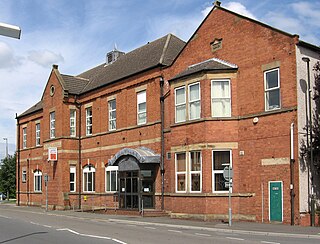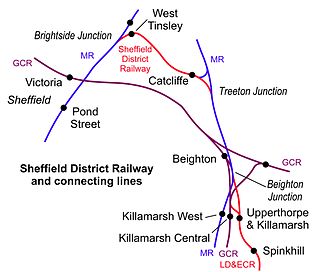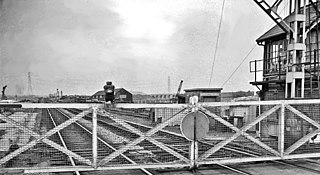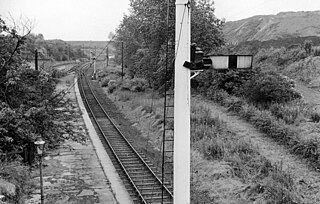
Staveley is a town and civil parish in the Borough of Chesterfield, Derbyshire, England. Located along the banks of the River Rother. It is northeast of Chesterfield, west of Clowne, northwest of Bolsover, southwest of Worksop and southeast of Sheffield.

The North Midland Railway was a British railway company, which opened its line from Derby to Rotherham (Masbrough) and Leeds in 1840.

Rotherham Masborough railway station was the main railway station for Rotherham, South Yorkshire, England from the 1840s until 1987, when most trains were rerouted via Rotherham Central. It had four platforms, with a large sandstone station building on the eastern Platform Four, large iron and glass platform canopies, a fully enclosed footbridge and wooden waiting rooms on the other platforms. It closed in 1988, except for a few football specials.

West Tinsley railway station is a former railway station in Sheffield, South Yorkshire, England.

Creswell railway station serves the village Creswell in Derbyshire, England. The station is on the Robin Hood Line between Nottingham and Worksop. It is also the nearest station to the larger village of Clowne.
The Sheffield District Rail Rationalisation Plan was a series of linked railway civil engineering projects, station and line closures and train route changes that took place in and around Sheffield, South Yorkshire. The majority of these changes took place in the 1960s and early 1970s, however the plan, by now much modified in the face of rapidly dwindling freight traffic, was not fully realised until the 1980s.

Catcliffe railway station is a former railway station in the Catcliffe area of Rotherham, South Yorkshire, England.

Beighton railway station is a former railway station near the village of Beighton on the border between Derbyshire and South Yorkshire, England.

Woodhouse Mill railway station was opened in 1840 by the North Midland Railway on its line between Rotherham Masborough and Chesterfield.

Treeton railway station is a former railway station in the centre of Treeton, Rotherham, England.

Staveley Central was a railway station serving the town of Staveley, Derbyshire, England.

Killamarsh West is a former railway station in Halfway, South Yorkshire, England.
Eckington and Renishaw railway station is a former railway station between Eckington and Renishaw in Derbyshire, England.
Whittington railway station is a former railway station on the southern edge of New Whittington, Derbyshire, England.

Staveley Town is a disused railway station in Staveley, Derbyshire in England.

Clowne & Barlborough is a former railway station in Clowne northeast of Chesterfield, Derbyshire, England.

Bolsover Castle is a former railway station in Bolsover, Derbyshire, England.
The Clowne Branch is a disused railway line in north eastern Derbyshire, England. Which runs from Creswell to Staveley. Historically it ran to Chesterfield. It is now in use as a greenway.
The Doe Lea branch is a mothballed railway line in Derbyshire, England. It connected the Derbyshire towns of Chesterfield, Staveley and Bolsover to the Nottinghamshire town of Mansfield. It also had a branch line to Creswell via the Derbyshire town of Clowne.
Beighton Junction is a set of railway junctions near Beighton on the border between Derbyshire and South Yorkshire, England.













